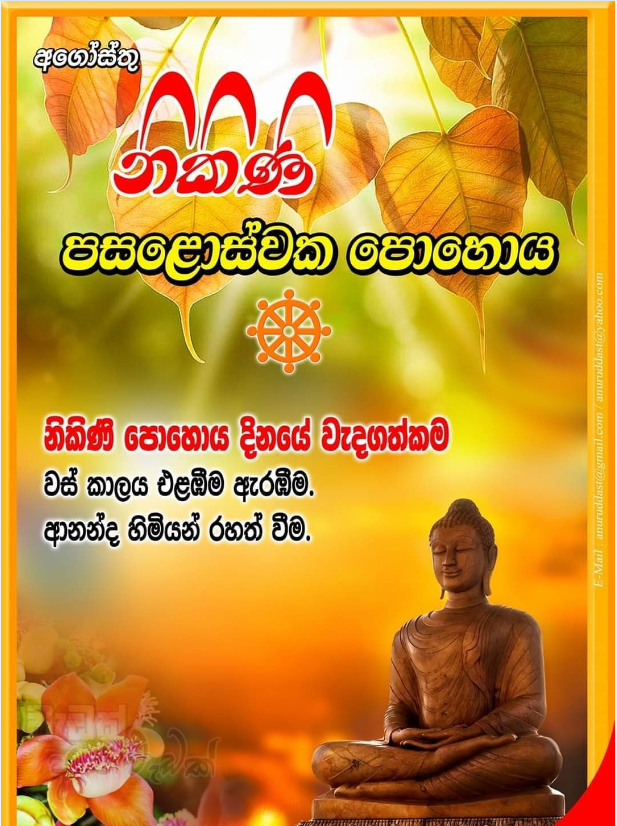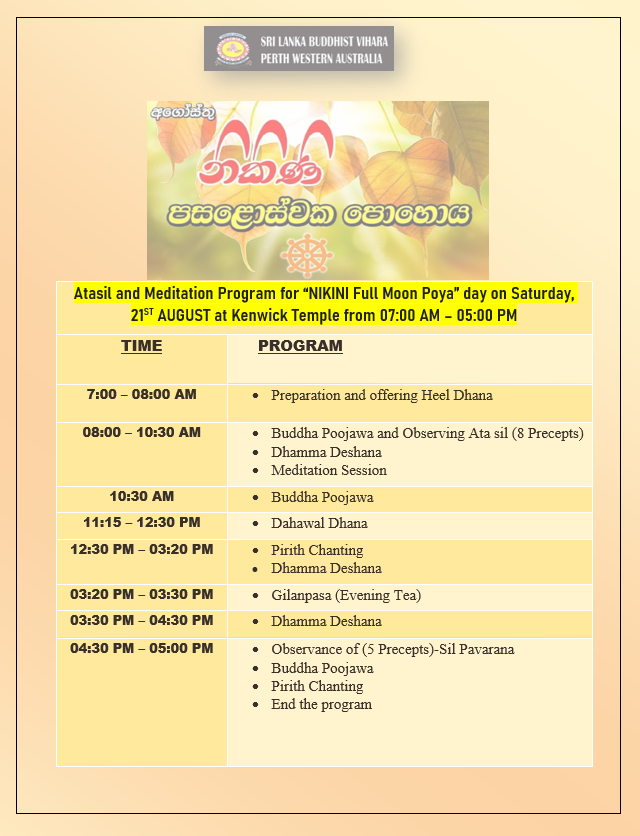
Nikini Poya

The attainment of Arahantship by Buddha’s Agraupastayake – Chief Attendant, Ven. Ananda Maha Thera, the commencement of the first Dharma Sangayana and the convocation to settle the Buddhist cannon ‘Pasu Vas’ or the commencement of the ‘Vas’ period — rainy season sojourn by Buddhist monks who have not commenced it on the Esala Full Moon Poya Day — are some of the significant occasions marked on the Nikini Full Moon Poya Day.
RAINY SEASON SOJOURN BY ASCETICS – PERA VAS AND PASU VAS
The rainy season in Dambadiva, India begins during the month of Esala (July/August). It is extremely cold in the snowy peaks of Himalayas and in the valleys where ascetics meditate under the shade of trees. Due to cold weather and heavy rain, it is not convenient for ascetics to sit under trees and meditate. Even birds build sheltered nests to live in during this season. Some of them even migrate to other countries where there is less rain and where the cold is not so severe. There is provision for Buddhist monks also to sojourn with householders during this season.
The Pali word ‘Vas’ means rain and ‘Viseema’ means dwelling. Hence ‘Vas Viseema’ means the sojourn during the rainy season of three months which begins on Esala Full Moon Poya Day. Commencing the vas on this day is called the ‘Purmikawa’ or Pera Vas. However, the Buddhist monks who fail to commence their vas period on the Esala Full Moon Poya Day are allowed to start observing Vas on Nikini Full Moon Poya Day. This late commencement of Vas or rainy season sojourn is called ‘Pasu Vas.’
SANTHAHA KARANAYA – HARDSHIPS CAUSED TO MONKS DUE TO RAIN
Buddhist monks commence their ‘Vas’ on Nikini Full Moon Poya Day in keeping with the enactment ‘Santhaha Karanaya.’ The circumstances which led to the enactment of Santhaha Karanaya were the hardships caused to some Bhikkhus due to rain. After the establishment of the Buddha Sasana, Bhikkhus engaged in the propagation of Dharma and meditation during all four seasons — spring, summer, autumn and winter — in spite of adverse weather conditions during the rainy season.
People were concerned about the hardships caused to Bhikkhus and pains taken by them which they thought was ‘Attakilamathanuyogaya’ – giving extreme pain to the body or physical exertion. Some people went to the extent of criticizing the extreme pains taken by Bhikkhus. These criticisms reached the ears of King Bimbisara.
VAS IN RAJAGAHANUWARA COMMENCING FROM NIKINI FULL MOON POYA
On the day before the Nikini Full Moon Poya Day, King Bimbisara requested the Buddha to sojourn for the rainy season in his kingdom – Rajagahanuwara from Nikini Full Moon Poya Day. The Enlightened One accepted this invitation. ‘Pasuvas’ or the custom of sojourning for the rainy season from Nikini Full Moon Poya came into being in that manner. Thus, Bhikkhus who fail to commence ‘Vaswiseema’ or sojourning for the rainy season from Esala Full Moon Poya Day can sojourn for the Vassana Kala from Nikini Full Moon Poya Day.
Buddha himself had to be away from his place of rainy season sojourning for about a week when he went to Rajagahanuwara on the invitation of King Bimbisara. On this occasion, the Enlightened One allowed his followers to be away from the place of rainy season sojourn for a week if they had to comply with the invitation of devotees.
THE FIRST DHARMA SANGAYANA
It was on the Nikini Full Moon Poya Day, three months after the Buddha ‘Parinibbana’ that the first Dharma Sangayana or the convocation was held to protect the Buddhist cannon. The immediate cause for conducting the first convocation or Dharma Sangayana was the behaviour of a monk by the name of Subaddha after Parinibbana of the Enlightened One.
LAMENTATION OVER PARINIBBANA OF THE ENLIGHTENED ONE
All ordinary bhikkhus who had not attained Arahantship excepting monk Subaddha lamented over the Parinibbana of the Buddha. Buddha’s Agra Upasthayake, ‘Dharma Bhandagarika’- the treasurer of Dharma, Ananda Maha Thera was among those who lamented. Monk Subaddha had become an ascetic during his old age not actually to practice it but because he had no other way of living. He had requested the monks not to mourn but to be happy as there was no one after Buddha to give them orders.
REASON TO HOLD THE FIRST CONVOCATION
Arahants led by Maha Kassapa Thera felt that the behaviour of ascetic Subaddha was an indication of problems among members of the Sangha community and on Esala Full Moon Poya Day, two months after the Parinibbana of the Buddha, decided to hold the convocation to settle the Buddhist cannon. This was the first Dharma Sangayana.
It was conducted during a period of seven months from the following Nikini Full Moon Poya Day. Even during the time of Buddha, problems arose among the Bhikkhus such as the ‘Sangha Beddha’ or division among bhikkhus (those versed in morals) and ‘Vinayadhara’ bhikkhus (those versed in and observed the precepts of property of conduct) but the Buddha settled them amicably.
ARAHANT MAHA KASSAPA THERA
Arahant Maha Kassapa Thera was a Bhikkhu who spent most of the time in Himalayas as an ascetic. This he did presumably to avoid being mistaken by the people for the Buddha as he was physically identical with the ‘Thathagatha.’
Maha Kassapa Thera was in the city of Pavaat the time of Buddha’s Parinibbana. As soon as he heard about the Maha Parinibbana, he came to Kusinara with his followers. Maha Kassapa Thera consoled the ordinary monks who mourned the Parinibbana of Gautama Buddha and after the funeral of the Thathagatha he made arrangements for the first Dharma Sangayana.
By that time Arahant Sariputta and Arahant Moggallyana had attained Parinibbana and the convocation was held under the patronage of Arahant Maha Kassapa and the royal patronage was provided by King Ajasatta. As unanimously decided by all the Bhikkhus, the first convocation was held at Saptapanni cave at the foot of the ‘Vehara rock’ Rajagahanuwara, Five hundred Arahants participated in the convocation. Arahant Maha Kassapa Thera originally selected 499 Arahants and after attaining Arahantship by Ananda Maha Thera on the previous day the vacancy was filled by him.
The convocation was held at Rajagahanuwara in Magadha Rata. Presumably, Arahant Maha Kassapa Thera was confident of Ananda Maha Thera’s attainment of Arahantship before the commencement of the Dharma Sangayana. It was because of this reason that a place was kept for him.
ATTAINMENT OF ARAHANTSHIP BY ANANDA MAHA THERA
Ananda Maha Thera had gained eminence in erudition and possessed a lot of knowledge in Dharma and was second only to Buddha in preaching. Buddha appreciated him when he preached Dharma to a group led by King Mahanama Sakya. He was ‘Dharma Bhandagarika’ – treasurer of Dharma having heard all the discourses of the Buddha. He was second only to Buddha in intelligence, good sense, prudence and circumspection. He had reached the apex in understanding and apprehension. In serving as ‘Agra Upasthayake’ – Buddha’s chief attendant, he did everything possible for the safety and comfort of the Buddha.
ANANDA MAHA THERA’S DETERMINATION TO SAVE BUDDHA FROM ELEPHANT NALAGIRI
When the furious elephant Nalagiri came chasing after the Buddha, the Thera stood in between the Buddha and the elephant exhibiting his courageousness when he felt the need. He was second only to Buddha in rationalism, prudence and wisdom. In spite of such virtues and good qualities, he did not attain Arahantship by the time of Buddha’s Parinibbana, presumably due to his desire and ambition to tender aid, to serve and wait upon the Buddha.
He had attained ‘Sowan’ – the first of four paths to Nirvana, having heard the Dharma preached by Arahant Punnamattanipatha Thera a few days after entering priesthood. Since he had not attained Arahantship, he could not bear the pain of mind when he heard about Buddha’s decision to attain Parinibbana. He leaned against the door at the temple and started crying.
ANANDA THERA REMINDED ABOUT THE TRANSITORY NATURE OF ALL EXISTING THINGS
Buddha summoned Ananda Maha Thera and consoled him, reminding him about the transitory nature of all existing things from which even the Thathagatha cannot deviate. Buddha said Ananda Maha Thera had accumulated enough merit to attain Arahantship before long and advised him to be courageous. Ananda Maha Thera made up his mind and did everything what ought to have been done.
ANANDA MAHA THERA INDISPENSABLE FOR THE CONVOCATION
When the first Dharma Sangayana was held, Ananda Maha Thera attained Arahantship and was qualified to fill the vacancy kept reserved for him by Arahant Maha Kassapa Thera. The vacancy was kept reserved because Ananda Maha Thera was indispensable for the successful convocation of the
Buddhist cannon.
He was the most knowledgeable person in the doctrine being the ‘Dharma Bhandagarika’- the treasurer of Dharma and having listened to all the discourses of the Enlightened One.
SEVEN MONTHS SPENT FOR THE CONVOCATION
The convocation went on for seven months. Dharma Pitake and Vinaya Pitake were classified into Digha Nikaya, Majjima Nikaya, Sanyutta Nikaya, Anguttara Nikaya and Kuddaka Nikaya.
They were learnt by heart. The responsibility for each part was entrusted to leading participants of the convocation. Arahant Ananda Maha Thera and his followers were entrusted with the responsibility for Digha Nikaya. The followers of Arahant Sariputta Maha Thera were entrusted with the Majjima Nikaya. Sanyutta Nikaya was entrusted with Arahant Kassapa Maha Thera and his followers.
Anguttara Nikaya was the responsibility of Arahant Anuruddha Maha Thera and his followers. All the Theras were made responsible for the Kuddaka Nikaya. Vinaya Pitaka was entrusted with Arahant Upali Maha Thera. At this convocation, the preludes or introduction to Dharma Sangati, Vibhanga Dhatukata, Puggala Pragnappti, and Yamaka Pattan of Abhidharma were also rehearsed.
PANCA SATHIKA SANGIKTHI
This convocation was called ‘Panca Sathika Sangikthi’ as it was held with the participation of 500 Theras who had attained Arahantship.

